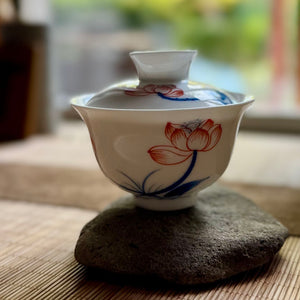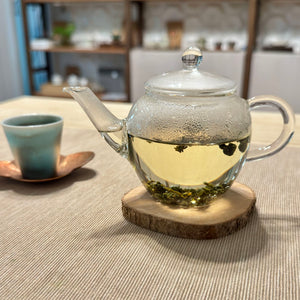Sencha brewing guide
How to make sencha tea? - Instructions
You've acquired some excellent sencha tea and you have a kyusu pot - but how do you start making it?
Japanese sencha is one of the most sensitive teas when it comes to steeping parameters. However, that makes it very versatile and customizable – which can be both exciting and daunting, especially for beginners.
This guide provides a solid starting point that is almost guaranteed to make delicious tea – every time.
Before we open the tea...
Let's review what you'll need to get the most out of your tea leaves.
Making tea doesn't require complicated tools, but well-chosen tools help make the experience consistent and enjoyable.
Basic tools:
-
Kyusu or hohin teapot
-
A teacup (e.g. yunomi)
-
Scale with an accuracy of at least 0.1 grams
-
Kettle
The three most important factors
-
Tea leaf-to-water ratio
-
Water temperature
-
Soaking time
These all affect the end result – if you have these in hand, you can much more influence what you get out of your tea.
Step by step: Making Sencha
Recommended default setting (for orthodox sencha):
1-2 g / 50 ml | 70–80°C | 60 sec, 0 sec, 45 sec
(This guide is for "normal" steamed 'sencha' - that is, the asamushi and chuumushi types.
Long-steamed, or fukamushi, 'senchas' require a slightly different method.)
Step 1 – Weigh the tea leaves
Use 1–2 grams of tea per 50 ml of water.
For higher quality teas, it is worth choosing a larger quantity.
Example: 3g of tea was used for a 70ml yunomi cup.
Step 2 – Fill your cup with freshly boiled water
This simultaneously measures the required amount of water and preheats the cup.
Meanwhile, the water cools to about 85–90°C.
Step 3 – Pour the leaves into the kyusu pot
Try to distribute the leaves evenly across the bottom of the pot.
Step 4 – Pour the water from the cup into the jug
The water poured into the cold pot cools down again, this time to around 75–80°C – ideal for 'sencha'.
Start the timer and soak for 60 seconds.
Step 5 – Wait patiently
Do not move the can or stir the leaves – this will avoid excessive dissolution.
If you want to cool the water further, leave the lid of the kettle open.
Step 6 – Fill it up and you're ready to drink.
Pour the tea slowly – this is how the flavor of Japanese teas unfolds most beautifully.
Some important reasons why you should charge slowly:
-
the filter does not clog
-
less fine tea grounds end up in the cup
-
the tea doesn't leak out of the pot unnecessarily
Important: always pour out every last drop, because that's where most of the flavor is.
If you're filling multiple cups, alternate between them (or use a pourer first) to ensure an even flavor.
Additional soakings - infusions:
A good quality sencha can last up to 3 infusions. Always leave the lid of the pot slightly open between infusions to allow the leaves to “breathe”.
-
Second pour : pour water on it again (as per the previous steps), but pour it out almost immediately – 0-5 seconds is enough.
-
Third pour : with slightly hotter water, with a soaking time of about 45 seconds .
+1 tip: Experiment!
One of the biggest advantages of sencha is that it is very customizable.
If you play with temperature, quantity and time, you will get completely different taste experiences – from the same tea.

Making tea in a Gaiwan
Brewing tea in a gaiwan is one of the most elegant and ancient forms of Chinese tea culture. This method allows us to discover new layers of flavor in the tea with each pour.
Making tea in a clay teapot
Brewing tea in a clay teapot adds a special depth and roundness to the drink, especially for oolong, puer or black teas. This traditional method enriches not only the tea, but also the tea-drinking experience.
Making cold brew tea
Cold brew tea is a refreshing, smooth and naturally sweet alternative to hot water brews. It's easy to make and ideal for summer days or on the go.

Making tea using a French press
A French press is a great tool not only for coffee but also for tea – fast, convenient and surprisingly efficient. It is the ideal choice for those who simply want to get the most out of their loose teas.


